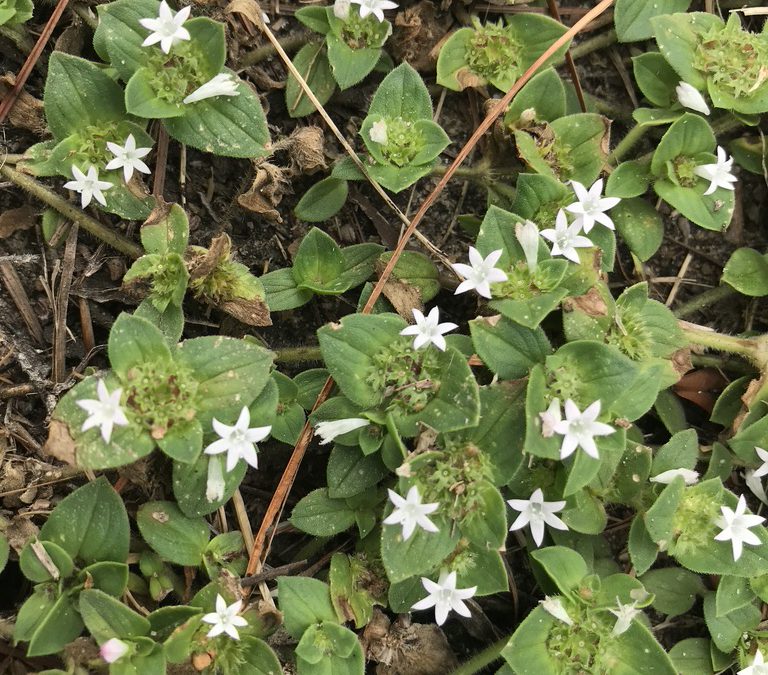
by Laura Tiu | Dec 3, 2020
Fall is such a spectacular time in the Florida Panhandle. The crowds are gone and the thermometer rests at a pleasant 50-70-something degrees. It is the perfect time of year to enjoy our amazing environment. Nature has a magical way of boosting our energy levels and immune systems and improving mood and focus. We can all use a heaping helping of that right now.
So where do you start? Here are some ideas.
 Take in a sunrise or sunset. The beach is often one of the best places to do this, but anywhere will do. Last weekend, I was at the Okaloosa Island Boardwalk and Pier and the sunset was magnificent. While there, take a walk along the beach, let the cool sand squish between your toes and discover what might be hiding in the wrack. The wrack is that line of seaweed deposited after high tide. Upon close inspection, it contains many treasures including seagrasses, sponges, shells, worm tubes, small crabs and other oddities.
Take in a sunrise or sunset. The beach is often one of the best places to do this, but anywhere will do. Last weekend, I was at the Okaloosa Island Boardwalk and Pier and the sunset was magnificent. While there, take a walk along the beach, let the cool sand squish between your toes and discover what might be hiding in the wrack. The wrack is that line of seaweed deposited after high tide. Upon close inspection, it contains many treasures including seagrasses, sponges, shells, worm tubes, small crabs and other oddities.
Take a nature hike. I love the nature trails at our local state and national parks, Henderson Beach, Topsail, Blackwater and Grayton Beach State Parks all have great trails. You may see some wildflowers this time of year. Look for animal tracks and resident birds. You may also see some monarch butterflies on the saltbush, resting as they continue their migration to Mexico.
Check out the springs. Morrison Springs and Ponce de Leon Springs in the state park in Walton County are an easy drive. Sit and enjoy the beauty and peaceful nature that surrounds the springs. Dip your toes in the cool water for a refreshing tingle or jump right in if you dare.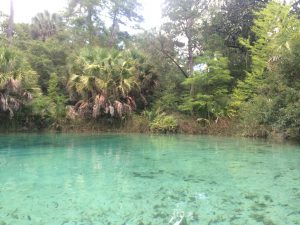
If you have a kayak, canoe or paddle board, it’s a great time to be on the water. Look for migrating shorebirds, schools of fish or pods of dolphins. Did you know we have over 60 dolphins that call the Destin area home year-round? You can often find them cruising in the Choctawhatchee Bay, or hop aboard one of our local dolphin cruises to catch a better glimpse.
Finally, our local fresh seafood is available year-round. Plan a picnic with some fresh shrimp or smoked mullet dip. Seafood offers many of the same benefits as time in nature, so double up on all the goodness that fall has to offer. Get outside and get happy!

by Rick O'Connor | Dec 3, 2020
Along the northern Gulf coast is a string of long-thin sand bar islands we call barrier islands. They are called this because they serve as a barrier to the mainland from open water storms. These long sandy islands are very dynamic and constantly shift and move with the tides, currents, and waves. They can shift as far as 300 feet after a strong hurricane.

The white quartz sand beaches of the barrier island in the northern Gulf of Mexico.
Photo: Molly O’Connor
Life on these islands can be very tough. In addition to the constantly moving sand, there is salt spray in the wind, intense sunlight much of the year, high winds at times, and little rainfall to provide freshwater. Even though our area can receive as much as 60 inches of rain a year, much of this falls in the northern end of the counties, and not on the beaches. That said, there are freshwater ponds on some the islands and even larger dune lakes in Walton County – there life is not as hard.
As you cross a barrier island from the Gulf to the bay, you will cross distinct environmental zones. These zones are defined by the abiotic factors wind and salt spray and are named by their dominant plant forms having distinct animal life associated with them.
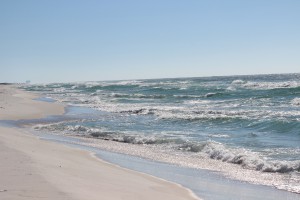
The beach zone seems life-less but it is not. Look beneath the sand.
Photo: Molly O’Connor
The beach is barren. This is the section of sand that extends from the water line of the Gulf to the first line of dunes. Few, if any plants can grow here. The high wave energy will not allow plants to grow along the shoreline, nor in the water itself. The wind and salt spray are high and the sand ever changing. All of the animal life here lives beneath the sand. They emerge when the wind and waves have slowed and scavenge on what they can find for food. Their primary production comes from the decomposition of the strands of seagrass and seaweed that line the shore – what we call wrack. Many will filter phytoplankton from the water as the waves wash in and seabirds are constant predators. When conditions get a little too much, they migrate a little offshore in deeper water to wait it out. But here fish and larger invertebrates become predators – so, they may not stay long.
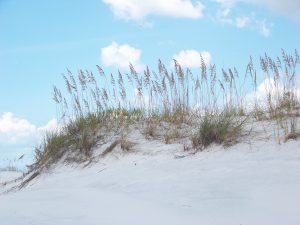
The primary dune is dominated by salt tolerant grasses like this sea oat.
Inland of the beach is the first dune line – the primary dune. This dune field is dominated by grasses because woody plants cannot tolerate the high wind. Most of these herbaceous plants have fibrous root systems that trap blowing sand and form dunes. The dominant grasses found here would include panic grass, beach elder, and the sea oat. The seeds of these plants provide food for creatures like the beach mice and some birds. Ghost crab burrows are often found here seeking shelter from the high energy environment of the beach. And, as you would expect, predators visit. Snakes, coyotes, and fox seeking the small mice.
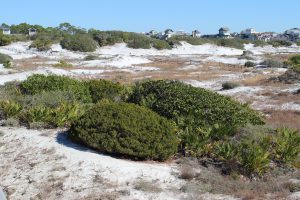
Small round shrubs and brown grasses within the swales are characteristic of the secondary dune field.
Photo: Rick O’Connor
This primary dune line blocks some of the wind and salt spray from the Gulf and allows small woody shrubs to grow. These shrubs will form a secondary dune system, which may grow slightly higher than the primary dunes. Shrubs like seaside rosemary, goldenrod, and false rosemary can be found here and give the dunes color when they are in bloom. The grasses found in the primary dune can also be found here. Beach mice and ghost crabs can work their way to this environment but because the wind is blocked by the primary dune other animals can be found here including: armadillos, opossum, a variety of snakes, and maybe even a gopher tortoise. Within the secondary dune field there are low areas that, at times, fill with rainwater. These are called swales and have their own unique wildlife. Grasses like broomsedge, needlerush, and bull rush can be found here. Along the edge you may find carnivorous plants such as the sundew. Freshwater attracts all wildlife, but the tenants could include a variety of amphibians, reptiles, and even some hardy species of fish.
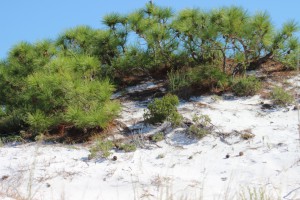
The top of a pine tree within a tertiary dune.
Photo: Molly O’Connor
On the back side of the island are some of the largest dunes. These are held in place by salt tolerant trees such as live oak, pine, and even magnolia. However, these trees look different than the ones that grow in our yards. They are the same species, but their growth seems stunted and often they look like the wind has blown their growth northward. This is known as wind sculpting and all of it is caused by the salt spray coming from the Gulf. These trees form a maritime forest where a variety of wildlife species do well. Deer, armadillo, opossum, skunks, coyote, fox, raccoon, hawks, owls, eagles, all sorts of snakes and woodland birds can be found here. In these xeric conditions, it is not uncommon to find a lot of cactus. Most of these creatures are hiding during the day, but at sunset they begin to move.
During these colder winter months, we encourage you to explore these beach habitats.
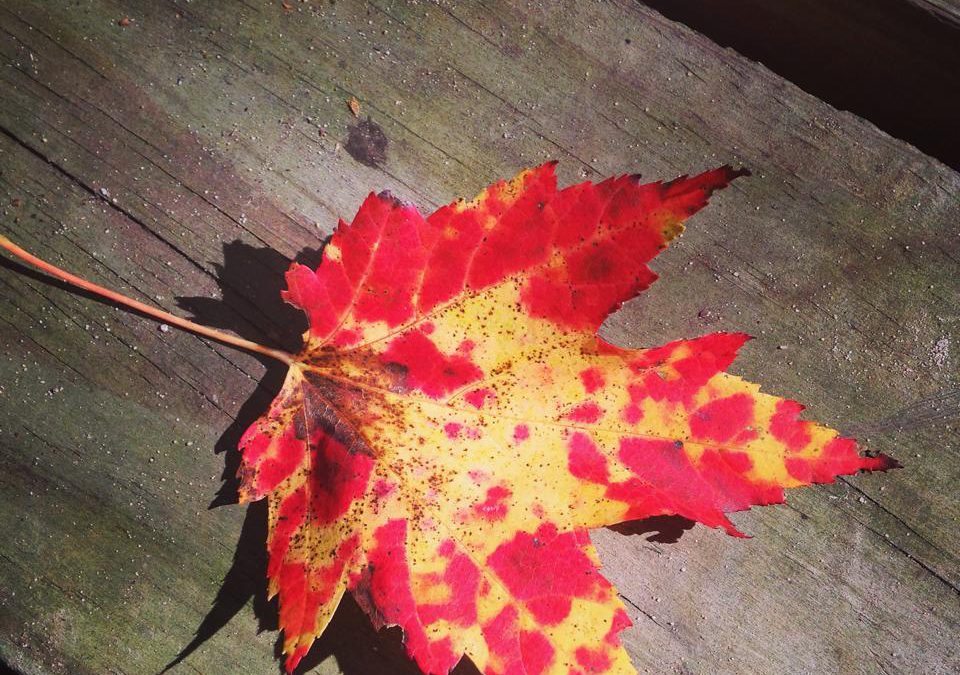
by Carrie Stevenson | Nov 18, 2020
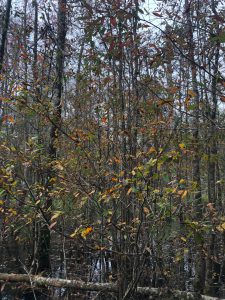
A blackgum/tupelo tree begins changing colors in early fall. Photo credit: Carrie Stevenson, UF IFAS Extension
It’s autumn and images of red, brown, and yellow leaves falling on the forest floor near orange pumpkins enter our minds. However, Florida isn’t necessarily known for its vibrant fall foliage, but if you know where to look this time of year, you can find some amazing scenery. In late fall, the river swamps can yield beautiful fall leaf color. The shades are unique to species, too, so if you like learning to identify trees this is one of the best times of the year for it. Many of our riparian (river floodplain) areas are dominated by a handful of tree species that thrive in the moist soil of wetlands. Along freshwater creeks and rivers, these tend to be bald cypress, blackgum/tupelo, and red maple. Sweet bay magnolia (Magnolia virginiana) is also common, but its leaves stay green, with a silver-gray underside visible in the wind.
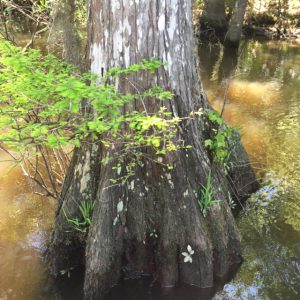
The classic “swamp tree” shape of a cypress tree is due to its buttressed trunk, an adaptation to living in wet soils. Photo credit: Carrie Stevenson, UF IFAS Extension
Bald cypress (Taxodium distichum) is one of the rare conifers that loses its leaves. In the fall, cypress tress will turn a bright rust color, dropping all their needles and leaving a skeletal, upright trunk. Blackgum/tupelo (Nyssa sylvatica) trees have nondescript, almost oval shaped leaves that will turn yellow, orange, red, and even deep purple, then slowly drop to the swamp floor. Blackgums and cypress trees share a characteristic adaptation to living in and near the water—wide, buttressed trunks. This classic “swamp” shape is a way for the trees to stabilize in the mucky, wet soil and moving water. Cypresses have the additional root support of “knees,” structures that grow from the roots and above the water to pull in oxygen and provide even more support.
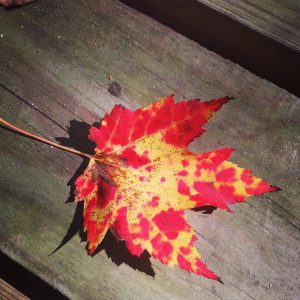
A red maple leaf displaying its incredible fall colors. Photo credit: Carrie Stevenson, UF IFAS Extension
The queen of native Florida fall foliage, however, is the red maple (Acer rubrum) . Recognizable by its palm-shaped leaves and bright red stem in the growing season, its fall color is remarkable. A blazing bright red, sometimes fading to pink, orange, or streaked yellow, these trees can jump out of the landscape from miles away. A common tree throughout the Appalachian mount range, it thrives in the wetter soils of Florida swamps.
To see these colors, there are numerous beautiful hiking, paddling, and camping locations nearby, particularly throughout Blackwater State Forest and the recreation areas of Eglin Air Force Base. But even if you’re not a hiker, the next time you drive across a bridge spanning a local creek or river, look downstream. I guarantee you’ll be able to see these three tree species in all their fall glory.
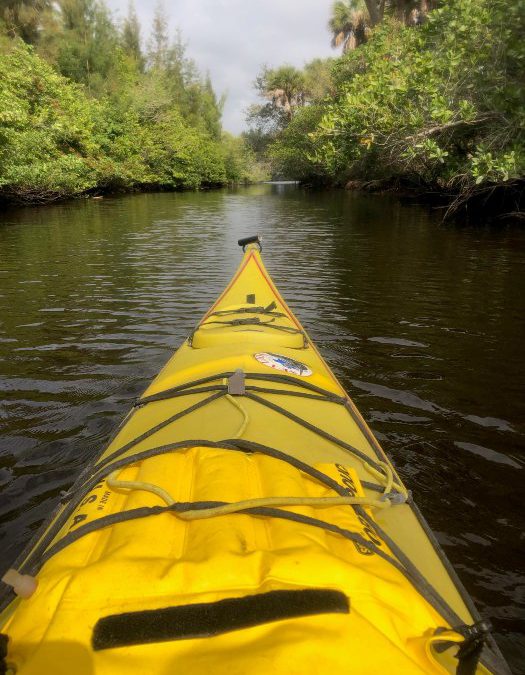
by Pat Williams | Oct 16, 2020
Pat is the County Extension Director and the Agriculture/Horticulture/Natural Resources agent for UF/IFAS Extension Wakulla County while also serving as the Master Gardener Volunteer Coordinator for both Franklin and Wakulla counties.
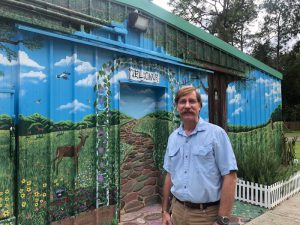
Pat by their outdoor mural at the Extension office.
He earned his doctorate from Texas A&M University in horticulture, a M.S. degree from Kansas State University in horticultural therapy, a B.S. degree in ornamental horticulture/floriculture from Cal Poly San Luis Obispo and an A.S. degree in ornamental horticulture from Crafton Hills College.
Over his horticulture career that started at age 13 working for Chrysanthemum Gardens in Crestline, CA, he has resided in 10 different states with a wide range of environmental influences (CA, KS, NJ, ME, NY, WA, TX, KY, TN and FL). He has held various positions in his career from teaching adults with developmental disabilities in NJ and ME, designing, installing and maintaining landscapes, landscape construction, being a horticultural therapist in New York City, working for the USDA in WA, teaching in a TX federal prison for his Extension appointment, teaching horticulture in a TN high school and was an university horticulture professor for 14 years in KY after teaching at Kansas State University, Washington State University and Texas A&M University as a teaching assistant. He started with the University of Florida/Institute of Food and Agricultural Sciences in April 2017 as the Sarasota County Residential Horticulture Agent/Master Gardener Volunteer Coordinator and transitioned to the Wakulla County Extension office in June 2020.
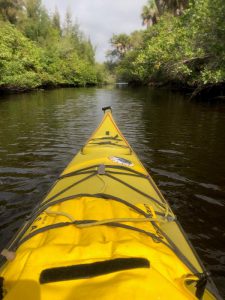
Kayaking the Myakka River, FL.
Teaching and greenhouse growing are his professional joys. Florida is the first state where there has not been a greenhouse to play in and he misses it greatly, however Extension does offer many opportunities to share his passion for plants and outdoors with a new group of learners. Otherwise Pat grew up on the beaches and ski resort areas of southern CA and still finds solace today relaxing on the beach or kayaking. He has traveled a bit visiting 49 states with only Hawaii to go. When indoors he would rather be baking or cooking in the kitchen as his second career choice would have been a chef. There is usually a yard full of flowers, herbs and vegetables and he is an extremely proud FSU Seminole Dad to Tara, a 2020 graduate.
Pat wears many hats at the Wakulla office and handles topics other than 4-H Youth Development or Family and Consumer Sciences. Once again he finds himself in a transition adapting to the new horticultural environment of Florida’s panhandle and developing more programs in agriculture and natural resources. Please feel free to reach out to see how the UF/IFAS Extension Wakulla County can be of assistance.
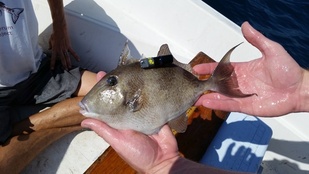
by Rick O'Connor | Oct 16, 2020
When most people think of reefs, they think of the coral reefs of the Florida Keys and Australia. But here in the northern Gulf the winters are too cold for many species of corals to survive. Some can, but most cannot and so we do not have the same type of reefs here.
That said, we do have reefs. We have both natural and artificial reefs. There are natural reefs off Destin and a large reef system off the coast of Texas – known as the “Flower Gardens”. Here the water temperatures on the bottom are warm enough to support some corals. The artificial reef program along the northern Gulf is one of the more extensive ones found anywhere. There is a science to designing an artificial reef – you do not just go out and dump whatever – because if not designed correctly, you will not get the fish assemblages and abundance you were hoping for. But if you do… they will come.
Reefs are known for their high diversity and abundance of all sorts of marine life – including fishes. There are numerous places to hide and plenty of food. Most of the fish living on the reef are shaped so they can easily slide in and out of the structure, have teeth that can crush shell – the parrotfish can actually crush and consume the coral itself, and some can be fiercely territorial. There are numerous tropical species that can be found on them and they support a large recreational diving industry. Let’s look at a few of these reef fish.
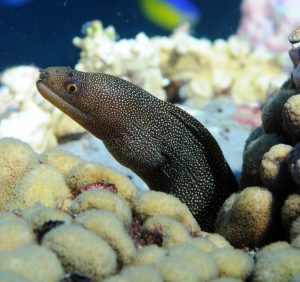
Moray eel.
Photo: NOAA
Moray Eels
These are fish of legend. There all sorts of stories of large morays, with needle shaped teeth, attacking divers. Some can get quite large – the green moray can reach 8-9 feet and weigh over 50 pounds. Though this species is more common in the tropics, it has been reported from some offshore reefs in the northern Gulf. There are three species that reside in our area: the purplemouth, the spotted, and the ocellated morays. The local ones are in the 2-3 foot range and have a feisty attitude – handle with care – better yet… don’t handle. They hide in crevices within the reef and explode on passing prey, snagging them with their sharp teeth. Many divers encounter them while searching these same crevices for spiny lobster. There are probing sticks you can use so that you do not have to stick your hand in there. There are rumors that since they have sharp teeth and tend to bite, they are venomous – this is not the case, but the bite can be painful.
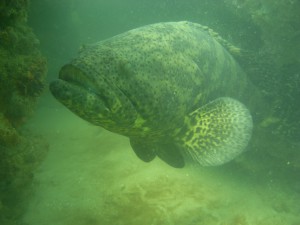
The massive size of a goliath grouper. Photo: Bryan Fluech Florida Sea Grant
Groupers
This word is usually followed by the word “sandwich”. One of the more popular food fish, groupers are sought by anglers and spearfishermen alike. They are members of the serranid family (“sea basses”). This is one of the largest families of fishes in the Gulf – with 34 species listed. 15 of these are called “grouper” and there have been other members of this family sold as “grouper”.
So, what is – or is not – a “grouper”. One method used is anything in the genus Epinephelus would be a grouper. This would include 11 species, but would leave out the Comb, Gag, Scamp, Yellowfin, and Black groupers – which everyone considers “grouper”. Tough call eh?
These are large bodied fish with broad round fins – the stuff of slowness. That said, they can explode, just like morays, on their prey. Anglers who get a grouper hit know it, and divers who spear one know it. They range in size from six inches to six feet. The big boy of the group is the Goliath Grouper (six feet and 700 pounds). They love structure – so natural and artificial reefs make good homes for them. They also like the oil rigs of the western Gulf.
An interesting thing about many serranids is the fact they are hermaphroditic – male and female at the same time. Most grouper take it a step further – they begin life as females and become males over time.
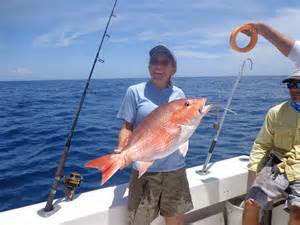
The king of finfish… the red snapper
Photo: Florida Sea Grant
Snappers
The red snapper is king. Prized as a food fish all over the United States, and beyond, these fish have made commercial fishermen very happy. With an average length of 2.5 feet, some much larger individuals have been landed. This fishery put Pensacola on the map in the early 20th century. Sailing vessels called “Snapper Smacks” would head out to the offshore banks and natural reefs, return with a load, and sell both locally and markets in New York. There are large populations in Texas waters and down on the Campeche Banks off Mexico. “Snapper Season” is a big deal around here.
Though these are reef fish, snapper have a habit of feeding above, and away from, them. You probably knew there was more than one kind of snapper but may not know there are 10 species locally. Due to harvesting pressure, there are short seasons on the famous red snapper – so vermillion snapper has stepped in as a popular commercial fishery – and it is very good also. Some, like the gray snapper, are more common inshore around jetties and seawalls. Also known as the black snapper or mangrove snapper, this fish can reach about three feet in length and make a good meal as well.
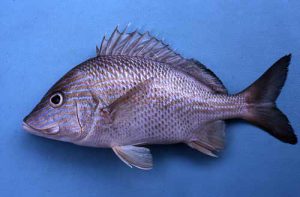
The white grunt.
Photo: University of Florida
Grunts
Grunts look just like snapper, and probably sold as them somewhere. But they are a different family. They lack the canines and vomerine teeth the snappers have – other than that, they do look like snapper. Easy to tell apart right? Vomerine are tiny teeth found in the roof of the mouth, in snappers they are in the shape of an arrow. They get their name from a grunting sound they make when grinding their pharyngeal teeth together. A common inshore one is called the “pigfish” because of this. They do not get as large as snapper (most are about a foot long) and are not as popular as a food fish, but the 11 known species are quite common on the reefs, and the porkfish is one of the more beautiful fish you will see there.
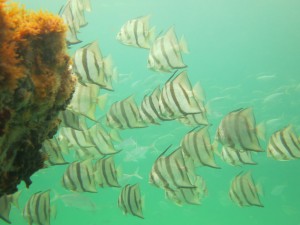
Spadefish on a panhandle snorkel reef.
Photo: Navarre Beach Snorkel
Spadefish
This is one of the more common fish found around our reefs. Resembling an angelfish, they are often confused with them – but they are in a family all to themselves. What is the difference you ask? The dorsal fin of the spade fish is divided into two parts – one spiny, the other more fin-like. In the angelfish, there is only one continuous dorsal fin.
Spadefish like to school and are actually good to eat. It is also the logo/mascot of the nearby Dauphin Island Sea Lab.
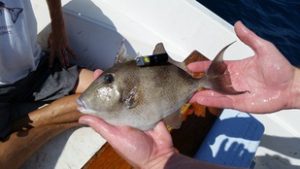
Gray triggerfish.
Photo: NOAA
Triggerfish
“Danger Will Robinson!” This fish has a serious set of teeth and will come off the reef and bite through a quarter inch wetsuit to defend their eggs. Believe it – they are not messing around. Once considered a by-catch to snapper fishermen, they are now a prized food fish. They are often called “leatherjackets” due to their fused scales forming a leathery like skin that must be cut off – no scaling with this fish. They have the typical tall-flat body of a reef fish, squeezing through the rocks and structure to hide or hunt. We have five species listed in the Gulf of Mexico, but it is the Gray Triggerfish that is most often encountered.
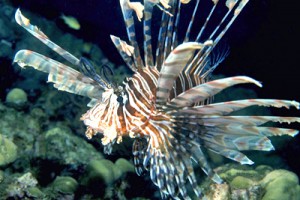
Photo courtesy of Florida Sea Grant
Lionfish
You may, may not, have heard of this one – most have by now. It is an invader to our reefs. To be an invasive species you must #1 be non-native. The lionfish is. There are actually about 20 species of lionfish inhabiting either the Indo-Pacific or the Red Sea region.
#2 have been brought here by humans (either intentionally or unintentionally – but they did not make it on their own) – this is the case with the lionfish. It was brought here for the aquarium trade. There are actually two species brought here: The Red Lionfish (Pterois volitans) and the Devilfish (Pterois miles). Over 95% of what has been captured are the red lionfish – but it really does not matter, they look and act the same – so they are just called “lionfish”.
#3 they must be causing an environmental, and/or an economic problem. Lionfish are. They have a high reproductive rate – an average of 30,000 offspring every four days. There is science that during sometimes of the year it could be higher, also they breed year-round. Being an invasive species, there are few predators and so the developing young (encapsulated in a gelatinous sac) drift with the currents to settle on new reefs where they will eat just about anything they can get into their mouths. There have been no fewer than 70 species of small reef fish they have consumed – including the commercially valuable vermillion snapper and spiny lobster. There is now evidence they are eating other lionfish.
They quickly take over a reef area and some of the highest densities in the south Atlantic region have been reported off Pensacola. However, at a 2018 state summit, researchers indicated that the densities in our area have declined in waters less than 200 feet. This is most probably due to the harvesting efforts we have put on them. They are edible – actually, quite good, and there is a fishery for them. Derbies and ecotours have been out spearfishing for them since 2010. You may have heard they were poisonous and dangerous to eat. Actually, they are venomous, and the flesh is fine. The venom is found in the spines of the dorsal, pelvic, and anal fins. It is very painful, but there are no records of anyone dying from it. Work and research on management methods continue.

by Andrea Albertin | Oct 2, 2020
If your private well was damaged or flooded due to hurricane or other heavy storm activity, your well water may not be safe to drink. Well water should not be used for drinking, cooking purposes, making ice, brushing teeth or bathing until it is tested by a certified laboratory for total coliform bacteria and E. coli.
Residents should use bottled, boiled or treated water until their well water has been tested and deemed safe.
- Boiling: To make water safe for drinking, cooking or washing, bring it to a rolling boil for at least one minute to kill organisms and then allow it to cool.
- Disinfecting with bleach: If boiling isn’t possible, add 1/8 of a teaspoon or about 8 drops of fresh unscented household bleach (4 to 6% active ingredient) per gallon of water. Stir well and let stand for 30 minutes. If the water is cloudy after 30 minutes, repeat the procedure once.
- Keep treated or boiled water in a closed container to prevent contamination
Use bottled water for mixing infant formula.
Where can you have your well water tested?

Contact your county health department for information on how to have your well water tested. Image: F. Alvarado Arce
Most county health departments accept water samples for testing. Contact your local department for information about what to have your water tested for (they may recommend more than just bacteria), and how to collect and submit the sample.
Contact information for Florida Health Departments can be found here: County Health Departments – Location Finder
You can also submit samples to a certified commercial lab near you. Contact information for commercial laboratories that are certified by the Florida Department of Health are found here: Laboratories certified by FDOH
This site includes county health department labs, commercial labs as well as university labs. You can search by county.
What should you do if your well water sample tests positive for bacteria?
The Florida Department of Health recommends well disinfection if water samples test positive for total coliform bacteria or for both total coliform and E. coli, a type of fecal coliform bacteria.
You can hire a local licensed well operator to disinfect your well, or if you feel comfortable, you can shock chlorinate the well yourself.
You can find information on how to shock chlorinate your well at:
After well disinfection, you need to have your well water re-tested to make sure it is safe to use. If it tests positive again for total coliform bacteria or both total coliform and E. coli call a licensed well operator to have the well inspected to get to the root of the problem.
Well pump and electrical system care
If the pump and/or electrical system have been underwater and are not designed to be used underwater, do not turn on the pump. There is a potential for electrical shock or damage to the well or pump. Stay away from the well pump while flooded to avoid electric shock.
Once the floodwaters have receded and the pump and electrical system have dried, a qualified electrician, well operator/driller or pump installer should check the wiring system and other well components.
Remember: You should have your well water tested at any time when:
- A flood occurred and your well was affected
- The color, taste or odor of your well water changes or if you suspect that someone became sick after drinking your well water.
- A new well is drilled or if you have had maintenance done on your existing well
- There has been any type of chemical spill (pesticides, fuel, etc.) into or near your well
The Florida Department of Health maintains an excellent website with many resources for private well users: FDOH Private Well Testing and other Reosurces which includes information on potential contaminants and how to maintain your well to ensure the quality of your well water.

 Take in a sunrise or sunset. The beach is often one of the best places to do this, but anywhere will do. Last weekend, I was at the Okaloosa Island Boardwalk and Pier and the sunset was magnificent. While there, take a walk along the beach, let the cool sand squish between your toes and discover what might be hiding in the wrack. The wrack is that line of seaweed deposited after high tide. Upon close inspection, it contains many treasures including seagrasses, sponges, shells, worm tubes, small crabs and other oddities.
Take in a sunrise or sunset. The beach is often one of the best places to do this, but anywhere will do. Last weekend, I was at the Okaloosa Island Boardwalk and Pier and the sunset was magnificent. While there, take a walk along the beach, let the cool sand squish between your toes and discover what might be hiding in the wrack. The wrack is that line of seaweed deposited after high tide. Upon close inspection, it contains many treasures including seagrasses, sponges, shells, worm tubes, small crabs and other oddities.























